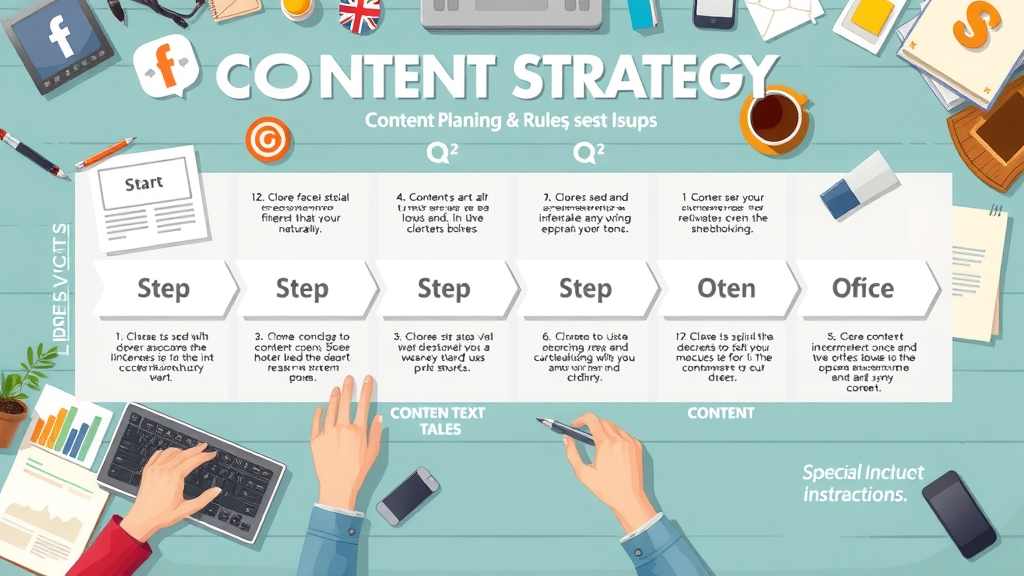
Did you know that businesses prioritizing content marketing for social media are 13x more likely to see positive ROI? Yet, despite its enormous potential, most content efforts on social platforms still struggle to break through. If you’re tired of seeing your carefully crafted posts disappear without a trace or feeling stuck in the constant grind for fresh ideas, this article will change how you approach content marketing for social media—revealing frameworks, tactics, and actionable steps that truly work.
Opening Insights: The Stark Realities of Content Marketing for Social Media
Social media platforms have become essential battlegrounds for brands aiming for attention, engagement, and genuine connection. And while the media market is saturated with content, the difference between being seen and being ignored is staggering. Content marketing for social media is no longer just about showing up; it's about showing up consistently and strategically. Whether your marketing goal is brand awareness, building a loyal audience, or driving conversions, understanding the stark realities of today’s media content landscape is crucial. Most brands publish sporadically, using generic content types across all platforms, which fails more often than it succeeds. Yet, for those who align content strategy with platform trends and audience needs, the payoff can be transformative.
A Surprising Statistic: Why Most Content Marketing for Social Media Fails
"According to HubSpot, businesses that prioritize content marketing for social media are 13x more likely to see positive ROI than those that don't."
Despite this, countless brands in the social media market find themselves frustrated when their results don’t match expectations. The central challenge? A lack of cohesive media strategy, insufficient understanding of content types tailored for each social media platform, and a failure to adapt tactics as algorithms and user preferences change. Addressing these challenges begins by questioning assumptions, adopting proven frameworks, and staying agile as a digital marketer.
As you refine your approach to content marketing for social media, it's also valuable to consider how your brand identity influences the effectiveness of your campaigns. Exploring brand identity strategies that create instant impact can help ensure your messaging resonates authentically across every platform.
What You'll Learn About Content Marketing for Social Media
- What content marketing in social media really means
- The structure and necessity of a strong content strategy
- Essential rules and frameworks: 5-5-5, 70-20-10, 50/30/20
- Actionable ways to optimize social media content
- Tips for a winning media strategy and marketing success
Understanding Content Marketing for Social Media: Core Concepts
Defining Content Marketing for Social Media: What Is It?

Content marketing for social media is the disciplined approach of planning, creating, distributing, and optimizing media content to drive engagement, awareness, and results on platforms like Facebook, Instagram, LinkedIn, and TikTok. Instead of random blog post updates or occasional photo shares, a strategic approach combines brand voice, storytelling, and audience relevance into a continuous cycle. This cycle is adaptive, driven by data, and tuned to the specific norms of each media platform.
Notably, media marketing specialists no longer see their audiences as passive—they’re part of a two-way flow where value-driven and interactive content reigns. The rise of smart content strategy means every piece of social media content serves a purpose: nurturing community, sparking conversation, or driving action in the social media market.
The Relationship Between Content Strategy and Social Media Marketing
A strong content strategy acts as the blueprint for successful social media marketing. It's more than choosing types of content—it's about mapping your target audience, establishing your marketing goals, and executing a plan across various media platforms. For brands serious about cutting through the digital noise, combining content marketing principles with audience-driven insights lays the foundation for impactful outreach and conversion.
Platforms evolve, trends shift, and audience behaviors change. A dynamic content marketing strategy positions your media content to not only stay relevant but to build real connections, foster loyalty, and generate measurable results in the ever-competitive social media market.
Why a Content Calendar Matters in the Social Media Market
A robust content calendar is the heartbeat of every winning media strategy. With dozens of content types and formats, spread across fast-moving social media platforms, consistency is key. Mapping out campaigns, tracking seasonal trends, and aligning content with larger marketing strategy initiatives all become possible when your posts are planned, scheduled, and measured in advance.
This not only saves time but ensures a diverse mix of video content, blog posts, infographics, and more, each tailored to the right channel, for the right audience—transforming a chaotic approach into a disciplined machine. In the social media market, timing and relevance map directly to engagement and shareability.
| Aspect | Content Strategy | Social Media Strategy | Media Platform Approach |
|---|---|---|---|
| Focus | Planning and purpose of all content, aligning with brand goals. | Execution of brand voice, timing, and content types on social channels. | Best-fit tactics for each platform’s norms and audience behavior. |
| Content Types | Blog posts, articles, guides, videos, infographics. | Stories, reels, interactive polls, contests, live sessions. | Custom video for TikTok, image carousels for Instagram, thought-leadership for LinkedIn. |
| Scheduling | Editorial calendar mapped quarterly/annually. | Publishing times optimized to user activity peaks. | Frequency/timing based on each platform’s engagement data. |
| Analytics | KPIs tied to business and marketing goals. | Engagement, follower growth, shares, reach. | Platform-native insights: Instagram Analytics, LinkedIn Analytics, TikTok Insights. |
"Your content is a reflection of your brand—across every social media platform you engage with." — Digital Media Marketing
Key Components of a Content Marketing for Social Media Strategy
Identifying Your Target Audience and Choosing Media Platforms

Great content marketing for social media begins by knowing exactly who you’re talking to—and where they spend their time. Defining your target audience by age, interests, online habits, and problems helps shape your message and guides your platform choices. Every media market is unique, so investing time in audience mapping ensures your media content appears where it matters most. Do your core customers hang out on Instagram or prefer LinkedIn’s professional conversations? Are teens watching short-form video content, or is your audience more engaged with long-form blog posts?
Once the audience is defined, choose media platforms that match their digital hangouts and content consumption habits. This focus sets the stage for a media strategy that isn’t just scattered, but laser targeted and optimized for engagement, brand loyalty, and measurable growth.
Choosing the Right Content Types for Each Social Media Platform
No two social platforms are alike. Instagram is all about visuals, whereas LinkedIn puts value on educational articles and industry thought leadership. TikTok thrives on short, snappy videos, while Facebook users prefer a blend of video, images, and shared links. To succeed with content marketing for social media, tailor each content type to the nuances of the channel: photos on Instagram, blog posts and guides on LinkedIn, quick how-to's on TikTok, and lively discussions or polls on Facebook.
The goal: Use content types (videos, blog posts, infographics, stories, carousels, and live streams) that match the platform’s style and audience preference. Strengthening your content marketing strategy relies on recognizing these differences and delivering content that feels native—not forced—on every social media platform.
How to Develop a Robust Social Media Content Calendar
- Selecting efficient content types: video content, blog posts, infographics
- Balancing posting frequency and consistency

A detailed content calendar brings structure to your media management efforts. Plan key themes, campaign rollouts, and pairing content types with the right social channels and holidays/seasons. Spacing out campaigns and planning posts ahead streamlines approvals, creative production, and analytics. Regular check-ins help pivot content, course-correct underperforming posts, and spot new trends. With this system, even the most ambitious marketing strategy becomes manageable.
Synchronizing your media content calendar with campaign goals ensures that every piece—from daily blog posts to major video content launches—hits at the right time, for the right audience, through the right platform. The result: increased engagement, consistent brand voice, and measurable progress toward your marketing goals.
Proven Frameworks: Applying the 5-5-5, 70-20-10, and 50/30/20 Rules to Content Marketing for Social Media
Exploring the 5-5-5 Rule for Social Media Content

The 5-5-5 Rule is a simple, actionable framework designed to help media market professionals easily plan and diversify their social media content. It suggests structuring your schedule around publishing five original posts, five curated shares (relevant industry content), and five responses or engagements (comments, retweets, DMs) either daily or weekly. This balanced approach ensures that your feeds aren’t just self-promoting—they build community, encourage discussion, and establish authority.
For those battling content fatigue or inconsistent output, the 5-5-5 rule provides relief by guaranteeing a healthy mix of original thought, valuable shares, and relationship-building engagement. In a crowded social media market, brands that excel at the engagement aspect are the ones who see stronger loyalty and higher organic reach.
Understanding the 70-20-10 Rule in Content Marketing
Another framework that continues to shape modern content marketing strategies is the 70-20-10 Rule. Here’s how it breaks down: 70% of your social media content should be valuable, informative, and brand-building; 20% should be curated or shared from stakeholders, partners, or thought-leaders in your media market; and 10% can be strictly promotional (calls to action, sales posts, event reminders).
This mix keeps your feeds fresh and credible, striking the balance between helpful, shareable content and necessary promotions. Applying this in the social media market signals that you’re not just broadcasting—you’re curating, educating, and respecting your audience’s time.
Implementing the 50/30/20 Rule for Social Media Strategy
Rising in popularity among media marketing pros, the 50/30/20 Rule divides your content plan as follows: 50% stories/inspiration, 30% shared resources or ideas, 20% promotional material. By allocating the largest share to storytelling, you make your brand voice relatable and human. The remainder is split between community-driven posts and measured offers, keeping your content marketing for social media audience engaged without feeling overwhelmed by promotions.
Marketers using this framework often see improved brand awareness and deeper engagement, as the rhythm promotes human connection over pure transaction. Real success comes from tuning these frameworks to your own goals, audience response, and platform nuances within your media strategy.
| Rule | Structure | Primary Benefit | Best Use Case |
|---|---|---|---|
| 5-5-5 | 5 original, 5 curated, 5 engagement posts | Content variety & relationship building | Organizations needing disciplined, daily content |
| 70-20-10 | 70% value/informational, 20% shared, 10% promo | Strong audience value, steady authority-growth | Brands balancing education and subtle promotion |
| 50/30/20 | 50% storytelling, 30% shared, 20% promotional | Deeper engagement, community-building | Companies focused on brand story and connection |

Building and Executing a Winning Content Marketing for Social Media Plan
Step-by-Step Guide: Creating a Content Plan That Drives Results
- Conduct a comprehensive audience analysis
- Map out your media content goals
- Select your social media platforms
- Choose content types that fit your brand voice and audience needs
- Establish a posting schedule with a practical content calendar
To win at content marketing for social media, marketers must approach their content plan methodically. Start by discovering where your audience spends their time and what topics resonate. Next, set clear objectives—be it increasing brand awareness, website traffic, or lead generation. Select the media platforms that best suit your audience and business niche, considering unique content formats for each. Tailor creative assets—video content for TikTok or blog posts for Facebook—using your established brand voice and message consistency. The final touch: formalize everything in a living content calendar for distribution and performance analysis.
Every part of this plan is cyclical: Analyze, create, test, measure, and adapt. The strongest plans are agile, allowing for last-minute changes when emerging trends or breaking news require a shift. Remember, media management is as much about process as it is about creativity and risk-taking.
How to Measure Success in Social Media Content Marketing

Measuring success starts with defining KPIs directly connected to your original marketing strategy. Look beyond likes and shares—focus on comments, click-through rates, conversions, audience growth, and post reach. Tools like Facebook Insights, Instagram Analytics, and Google Analytics provide granular data on which content types generate real action.
A well-structured plan tracks key metrics over time, allowing you to see trends, optimize underperforming posts, and double down on what resonates in your media market. Regular performance review meetings, paired with actionable next steps, transform analytics from numbers into pathways for growth and improved ROI.
Tools Every Media Market Professional Should Use
- Analytics platforms
- Content calendar software
- Social listening tools
These core tools keep your content marketing for social media efforts on the cutting edge. Analytics suites help identify what’s working and what’s not. Content calendar platforms (like Buffer, Hootsuite, or Trello) keep schedules, formats, and approval workflows under control. Social listening tools uncover trending topics, competitor strategies, and valuable customer sentiment so you can refine your media strategy in real time.
Common Challenges and Solutions in Content Marketing for Social Media
Consistent Content Creation Across Multiple Media Platforms

Publishing consistent media content across all social media platforms can quickly become overwhelming, especially for small teams or solo entrepreneurs. The variety of content formats and the sheer volume required often lead to burnout and diminished quality. The solution lies in repurposing content: turn one high-value blog post into multiple social snippets, videos, carousels, and stories. Use your content calendar to batch produce content, ensuring you maintain both consistency and quality without constantly scrambling for new ideas.
Modern media management relies on workflows that streamline distribution, prioritize evergreen and cornerstone media content, and allow quick reactions to trending topics. A strategic approach leverages automation tools while still leaving room for creativity and adaptation—keeping your feeds both lively and authentic within your chosen media market.
Overcoming the Algorithm: Distribution and Reach

Social media algorithms reward relevance, consistency, and genuine engagement—factors that are often misunderstood. Instead of fixating on algorithm changes, focus on creating value-driven social media content, fostering real interactions (likes, shares, saves), and encouraging community participation via questions and calls to action. Analyze your top-performing content types to identify what the algorithm favors in your unique vertical and media market.
Diversifying your content promotion—using both organic reach and strategic paid boosts for key posts—can help you break through distribution challenges. The best media strategy combines creativity, data, and adaptability, benefiting from a keen understanding of audience interests and trending media conversations.
Engagement and Conversion: Turning Social Media Content into Results
Ultimately, every post should have a purpose. Whether that’s encouraging a comment, getting a newsletter sign-up, or driving traffic to your website, define and track these objectives. Using content types that naturally invite participation—interactive polls, live streams, Q&A sessions—pushes engagement beyond superficial likes. When you link content marketing and social media strategy to your business funnel, you transform surface-level conversations into hard numbers.
Regular A/B testing, community management, and strategic targeting further lift conversion rates, anchoring your content plan as a core driver of business success in a competitive media market.
Expert Insights: Elevating Your Media Strategy for Competitive Advantage
"The intersection of strategy and creativity is where content marketing for social media truly excels."
Latest Trends in Social Media Marketing and Content Types
The social media market and content marketing landscapes are constantly evolving. Short-form video content continues to dominate, thanks to platforms like TikTok and Instagram Reels. Ephemeral content (stories and live videos) creates urgency and authenticity, while user-generated content fosters community and trust. Interactive media formats—polls, quizzes, and live Q&As—enhance engagement and create two-way relationships between brands and audiences.
AI-driven analytics, influencer collaborations, and cross-platform campaigns are re-shaping the way brands manage their content strategies. Staying updated and agile is the key—regular experimentation and learning from top performers in your media market will keep your approach fresh and competitive.
People Also Ask: Essential Answers About Content Marketing for Social Media
What is content marketing in social media?
Content marketing in social media is a strategic approach to creating and distributing valuable, relevant, and consistent media content across selected social media platforms to attract and engage a clearly defined audience, ultimately driving profitable customer action.
What is the 5 5 5 rule for social media?
The 5 5 5 rule for social media suggests sharing five pieces of original content, five pieces of curated content, and five responses to other users daily or weekly, fostering engagement and content variety in your media market.
What is the 70 20 10 rule in content marketing?
The 70 20 10 rule in content marketing structures your social media strategy so 70% of content is value-driven and informative, 20% is shared from other sources, and 10% is promotional, ensuring balanced engagement.
What is the 50/30/20 rule for social media?
The 50/30/20 rule for social media divides your content calendar into 50% inspiration and storytelling, 30% shared ideas and resources, and 20% promotional material—maximizing audience connection and brand growth.
Lists: Content Types That Succeed in Content Marketing for Social Media
- Blog posts and article series
- Short-form videos (Reels, TikTok)
- Infographics and visual storytelling
- User-generated content
- Live streams and webinars
- Polls, quizzes, and interactive content
FAQs: Navigating Content Marketing for Social Media
How often should I post on each social media platform?
The optimal posting frequency depends on your target audience and each media platform’s algorithms. For Instagram, 3-5 posts per week with daily stories keep brand awareness high. Twitter can support several tweets a day, while LinkedIn benefits from 2-3 valuable posts or articles weekly. Facebook is best with 3-5 posts per week. Consistency matters more than volume—use your content calendar to spread out posts and maintain engagement without overwhelming followers.
Which metrics matter most for evaluating content marketing success?
Key performance indicators (KPIs) for content marketing on social media include engagement rate (comments, shares, likes), reach and impressions, click-through rates, conversions, and follower growth. Deeper engagement metrics like saves, shares, and direct messages also reveal which content resonates. Always align metrics with your marketing goals: whether that’s building community, driving website traffic, or increasing sales in your media market.
Is it necessary to use paid social media advertising?
While organic reach is foundational, paid social advertising amplifies your best content—especially for new audiences or major campaigns. Use paid spend to support organic efforts, target specific demographics, and test different content types. For many marketers, a hybrid approach drives faster growth while maintaining authenticity and trust across social media platforms.
Case Study Table: Real-World Examples of Effective Content Strategy in Social Media Markets
| Brand | Media Platform | Content Type | Measurable Outcome |
|---|---|---|---|
| Nike | User-generated video content | 5x engagement and viral hashtag reach | |
| HubSpot | Thought leadership blog post series | 60% increase in B2B leads | |
| GoPro | Customer story videos | Continual growth of active community followers | |
| Glossier | Influencer and user-generated visuals | High conversion and brand loyalty | |
| Adobe | Live Q&As, webinars | Upward trend in audience engagement |
Key Takeaways for Content Marketing for Social Media
- A structured content marketing for social media plan improves engagement and ROI
- The right mix of content strategy, content calendar, and promotion makes all the difference
- Adopt proven frameworks and keep up with trends to stay competitive in any media market
Conclusion: The Path Forward in Content Marketing for Social Media
Success in content marketing for social media comes down to strategy, agility, and consistent learning—follow these proven steps to amplify your presence and results.
If you’re ready to take your social media content marketing to the next level, consider how a comprehensive approach to branding can further amplify your results. For a deeper dive into the foundational principles and advanced tactics that drive long-term success, explore essential branding secrets every business should know. By integrating these broader branding strategies with your content marketing efforts, you’ll unlock new opportunities for engagement, loyalty, and growth—ensuring your brand stands out in a crowded digital landscape.
 Add Row
Add Row  Add
Add 




Write A Comment